Regulation of the content of the packaging
Batch Content Regulations
by marketing on 4 de October de 2022
It is important for both brand image and consumer rights to ensure homogeneity in production and to prevent products marketed in different packaging from differing from one another. This requires product uniformity not only in terms of format, but also in terms of quantity. For example, if a consumer buys a product whose packaging is marked 100 g, it is essential that the content inside is actually that quantity, with the marked tolerances. In order to ensure greater market transparency, a number of rules, directives and decrees are being put in place to ensure that this is the case.
Who regulates these requirements?
Firstly, the International Organisation of Legal Metrology is responsible for establishing the legal metrology requirements for packaged products labelled in constant quantities.
On a second level, the European Union promotes directives concerning nominal quantities for packaged products, sets tolerances, maximum permissible errors and the mandatory use of metrologically controlled instruments.
Finally, the government of each country decrees laws that respect these European directives. In our case, these are the Royal Decrees, which must be complied with by all packagers and manufacturers in Spain.
On a second level, the European Union promotes directives concerning nominal quantities for packaged products, sets tolerances, maximum permissible errors and the mandatory use of metrologically controlled instruments.
Finally, the government of each country decrees laws that respect these European directives. In our case, these are the Royal Decrees, which must be complied with by all packagers and manufacturers in Spain.
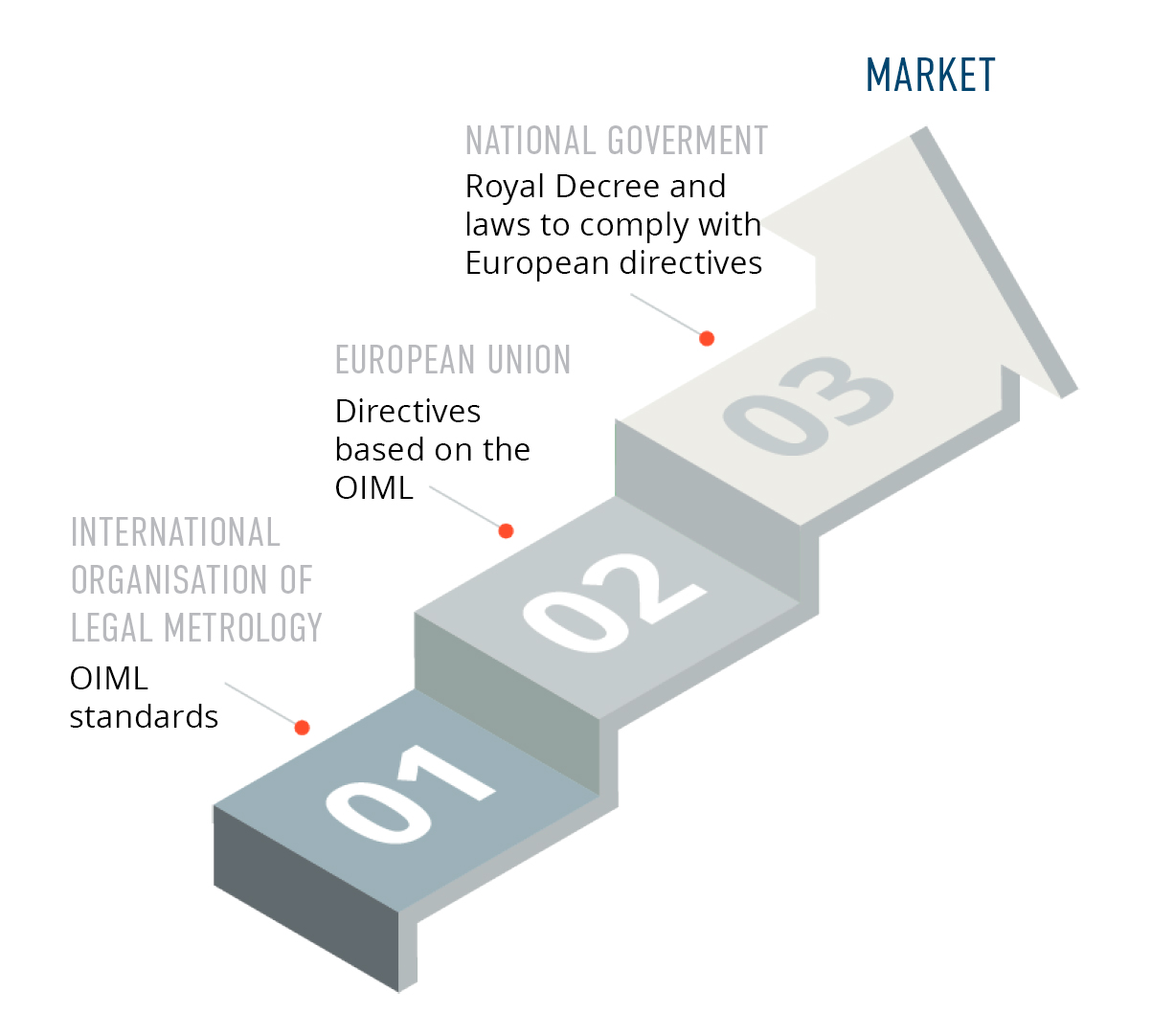
How is compliance with these requirements regulated?
Some of the regulations affecting packers are as follows:
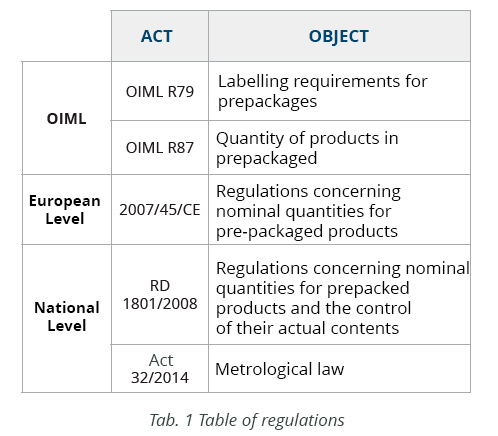
RD 1801/2008
For the packager, one of the most important rules is RD 1801/2008, with regulations concerning nominal quantities for packaged products and the control of their actual content.
WHAT IS THE PURPOSE OF THE ROYAL DECREE?
- To establish rules on nominal quantities for products put into packaging.
- To set content tolerances.
- To set maximum permissible errors.
- To establish modalities for the statistical control of the contents of packaged products.
- To establish the responsibilities of natural or legal persons in relation to the packaging of products.
- To establish rules on nominal quantities for products put into packaging.
- To set content tolerances.
- To set maximum permissible errors.
- To establish modalities for the statistical control of the contents of packaged products.
- To establish the responsibilities of natural or legal persons in relation to the packaging of products.
SCOPE
Any consumer packaged product between 5 g or 5 mL and 10 kg or 10 L, with the exception of products listed in Annex I and sold in duty-free shops for consumption outside the European Union.
Any consumer packaged product between 5 g or 5 mL and 10 kg or 10 L, with the exception of products listed in Annex I and sold in duty-free shops for consumption outside the European Union.
WHO IS RESPONSIBLE?
The natural or legal person whose name, company name or denomination appears on the packaging label or the importer established in the European Union, where applicable, is responsible for ensuring that the packaging complies with the requirements of this Royal Decree.
The law contemplates minor, serious and very serious infringements, and depending on these there are established fines.
The natural or legal person whose name, company name or denomination appears on the packaging label or the importer established in the European Union, where applicable, is responsible for ensuring that the packaging complies with the requirements of this Royal Decree.
The law contemplates minor, serious and very serious infringements, and depending on these there are established fines.
WHAT CONCEPTS DOES IT DEFINE?
Reduced design and manufacturing time and reduced upgrade time.
Reduced design and manufacturing time and reduced upgrade time.
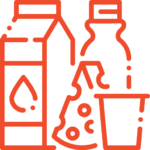
Packaged product
A packaged product is a product intended for sale to the consumer in constant nominal unit quantities equal to values preset by the packager.
Expressed in units of mass or volume, they are packaged in such a way that the quantity of product they contain cannot be varied without the package being opened.
Expressed in units of mass or volume, they are packaged in such a way that the quantity of product they contain cannot be varied without the package being opened.

Nominal quantity
This is the mass or volume of product marked on the labelling of the package, i.e. the quantity of product that the package is estimated to contain.

Actual content
The amount (mass or volume) of product actually contained in the package.

Maximum tolerated error of defect
The "maximum tolerated error of defect" in a package is the maximum quantity that can deviate by less than the nominal quantity.
GENERAL PRINCIPLES OF CONTENT CONTROL
The regulations contain a number of general principles on the control of the actual contents which must be complied with:
- The average actual content of the batch shall not be less than the net weight stated on the packaging.
- The proportion of packages between the lower tolerances (TU 1 and TU 2) must be less than 2.5% in accordance with OIML R 87.
accepted percentage.
- No package shall have an error greater than twice the maximum tolerated error TU 2.
The regulations contain a number of general principles on the control of the actual contents which must be complied with:
- The average actual content of the batch shall not be less than the net weight stated on the packaging.
- The proportion of packages between the lower tolerances (TU 1 and TU 2) must be less than 2.5% in accordance with OIML R 87.
accepted percentage.
- No package shall have an error greater than twice the maximum tolerated error TU 2.
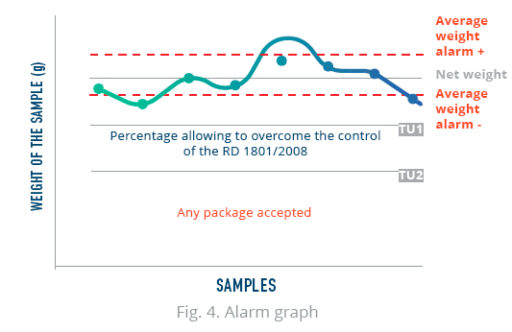
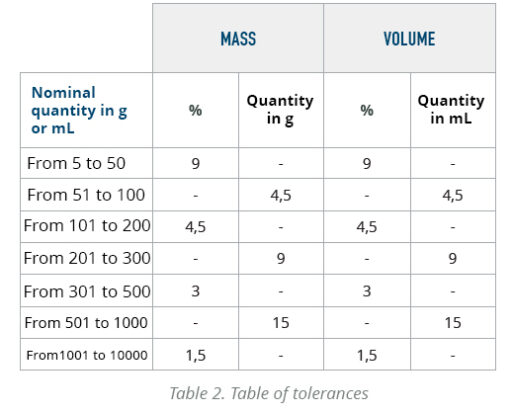
TOLERANCES
RD 1801/2008 defines the following maximum tolerances (TU1):
Example of tolerances
A package with a nominal quantity of 350 g is available. To calculate the TU1, the maximum tolerated error by defect is found in table 1 and in this case it is 3.0 %. The TU1 = 350 * 0,03 = 10,5 g. The TU2 is twice the maximum error per defect tolerated, TU2 = 10,5 * 2 = 21 g.
RD 1801/2008 defines the following maximum tolerances (TU1):
Example of tolerances
A package with a nominal quantity of 350 g is available. To calculate the TU1, the maximum tolerated error by defect is found in table 1 and in this case it is 3.0 %. The TU1 = 350 * 0,03 = 10,5 g. The TU2 is twice the maximum error per defect tolerated, TU2 = 10,5 * 2 = 21 g.
METROLOGY AND CONTROL INSTRUMENTS
The RD 1801/2008 decree also specifies that the effective content must be measured or controlled using a measuring instrument subject to metrological control.
These instruments must meet certain common requirements for design, operation, manufacturing controls and tests for their commissioning. Once the instruments have passed the necessary controls for putting into service, they must pass a periodic verification every two years and, if appropriate, a verification after repair.
The RD 1801/2008 decree also specifies that the effective content must be measured or controlled using a measuring instrument subject to metrological control.
These instruments must meet certain common requirements for design, operation, manufacturing controls and tests for their commissioning. Once the instruments have passed the necessary controls for putting into service, they must pass a periodic verification every two years and, if appropriate, a verification after repair.
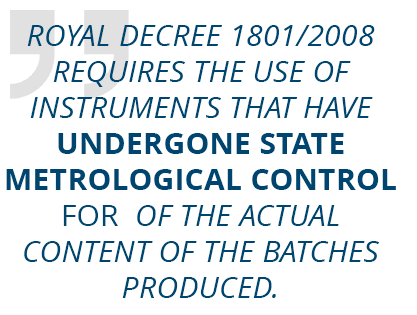
CONFORMITY MARKING
The CE symbology identifies the application of a harmonised European control. The letter M, which represents the metrological compliance mentioned above, is accompanied by the last digits of the year in which it was put into service. Finally, the digits corresponding to the identification of the Notified Body that carried out the conformity assessment are added.
Likewise, packaging that complies with the inspection procedures established in Royal Decree 180172008 may receive the CE mark, which certifies that the packaging complies with its provisions.
The CE symbology identifies the application of a harmonised European control. The letter M, which represents the metrological compliance mentioned above, is accompanied by the last digits of the year in which it was put into service. Finally, the digits corresponding to the identification of the Notified Body that carried out the conformity assessment are added.
Likewise, packaging that complies with the inspection procedures established in Royal Decree 180172008 may receive the CE mark, which certifies that the packaging complies with its provisions.
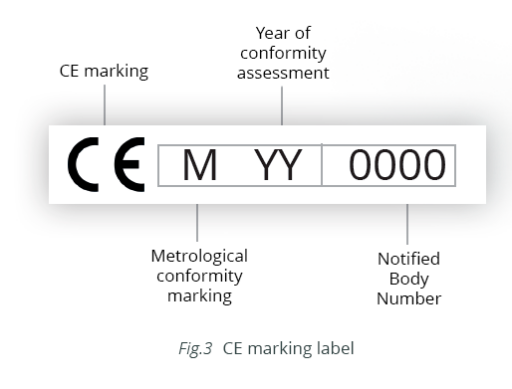
Law 32/2014
The purpose of Law 32/2014, of 22 December, on Metrology is to establish and apply the Legal System of Measurement Units, as well as to establish the principles and general rules to which the organisation and legal regime of metrological activity in Spain must conform.
This law also mentions some rules that affect the manufacturer and packager of the product:
The purpose of Law 32/2014, of 22 December, on Metrology is to establish and apply the Legal System of Measurement Units, as well as to establish the principles and general rules to which the organisation and legal regime of metrological activity in Spain must conform.
This law also mentions some rules that affect the manufacturer and packager of the product:
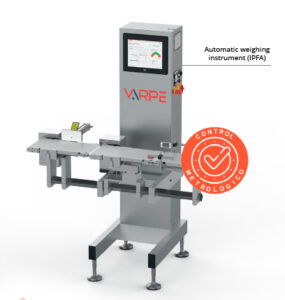

Article 8
The instruments (...) which serve to measure or count and which are used for reasons of (...) protection or information for consumers and users (...) shall be subject to the metrological control of the State under the terms established in their specific regulations".
The instruments (...) which serve to measure or count and which are used for reasons of (...) protection or information for consumers and users (...) shall be subject to the metrological control of the State under the terms established in their specific regulations".

Article 13.1
Pre-packaged products shall comply with the conditions laid down in the relevant metrological regulations on the control of their contents.
Pre-packaged products shall comply with the conditions laid down in the relevant metrological regulations on the control of their contents.

Article 13.2
Pre-packaged products shall bear on their packaging, wrapping or labelling an indication of the quantity of material or goods which they contain, which shall be expressed in accordance with the Legal System of Units of Measurement, in legible characters and in places where it can be easily seen.
Pre-packaged products shall bear on their packaging, wrapping or labelling an indication of the quantity of material or goods which they contain, which shall be expressed in accordance with the Legal System of Units of Measurement, in legible characters and in places where it can be easily seen.
Compliance-oriented checkweigher features
Varpe offers Automatic Checkweighing Instruments (AWI), also known as automatic checkweighers.
Some of the functionalities developed for this purpose are shown below.
Varpe offers Automatic Checkweighing Instruments (AWI), also known as automatic checkweighers.
Some of the functionalities developed for this purpose are shown below.
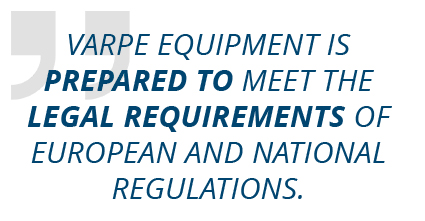
PERCENTAGE OF ACCEPTED FUNCTION
In the percentage of accepted function, the instrument rejects the containers between TU1 and TU2 that exceed the programmed percentage with respect to the total number of correct ones. This will depend on the strategy to be followed.
Programming the instrument with 0% would be the most restrictive case. The system will interpret that any container whose weight is between TU1 and TU2 should not be accepted as correct. If the user wants to be more permissive, a value higher than 0% can be programmed.
In the percentage of accepted function, the instrument rejects the containers between TU1 and TU2 that exceed the programmed percentage with respect to the total number of correct ones. This will depend on the strategy to be followed.
Programming the instrument with 0% would be the most restrictive case. The system will interpret that any container whose weight is between TU1 and TU2 should not be accepted as correct. If the user wants to be more permissive, a value higher than 0% can be programmed.
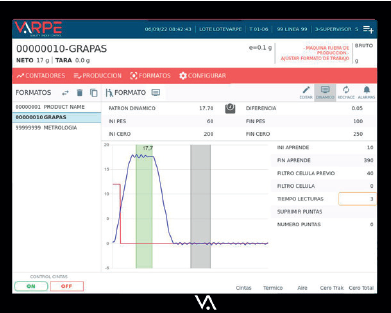
AVERAGE WEIGHT REJECT FUNCTION
It can happen that all the containers are within the T1U limit but the average weight of the production does not reach the nominal quantity marked on the container. For these cases, the average weight rejection function has been developed.
This function analyses where the average weight is. If it is below the net weight and the container that is passing makes the average weight drop further, it rejects it.
It can happen that all the containers are within the T1U limit but the average weight of the production does not reach the nominal quantity marked on the container. For these cases, the average weight rejection function has been developed.
This function analyses where the average weight is. If it is below the net weight and the container that is passing makes the average weight drop further, it rejects it.
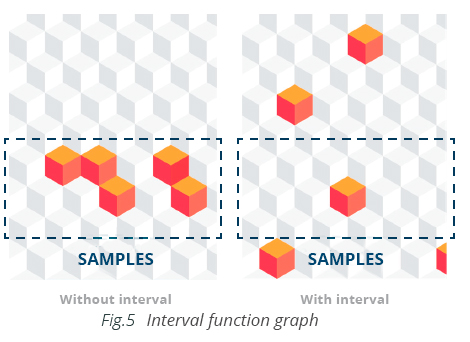
INTERVAL FUNCTION
Varpe has developed the interval function, which avoids sampling problems by spacing the packages between TU1 and TU2 by the intervals you define. For example, if an interval of 20 is programmed, every time 1 package is accepted as correct whose weight is between TU1 and TU2, the instrument will not accept another package under the same concept until the defined interval is met.
Varpe has developed the interval function, which avoids sampling problems by spacing the packages between TU1 and TU2 by the intervals you define. For example, if an interval of 20 is programmed, every time 1 package is accepted as correct whose weight is between TU1 and TU2, the instrument will not accept another package under the same concept until the defined interval is met.
